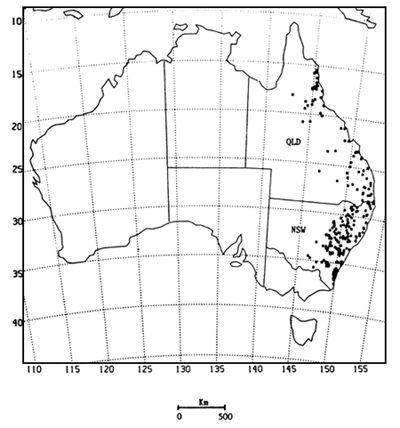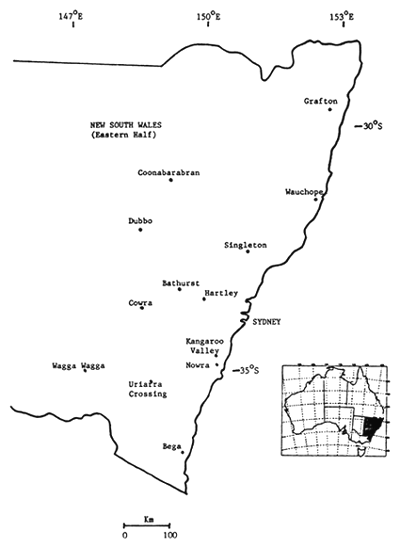by
M.L. Merwin
International Tree Crops Institute, P.O. Box 888, Winters
California, 95694, U.S.A.
and
S. Roffey
Tree Seed Centre, Division of Forest Research, CSIRO, P.O. Box 4008
Queen Victoria Terrace, Canberra, 2600 Australia
INTRODUCTION
River oak (Casuarina cunninghamiana Miq.) is widely planted both in Australia and elsewhere for fuelwood production, shelter, erosion control and amenity purposes. A collection of seed of river oak was undertaken through the Tree Seed Centre (CSIRO), to provide the opportunity to evaluate the performance of trees from throughout the temperate part of the species' range in varying field environments, but especially those subject to winter frosts. This aim was achieved by collecting seed from a representative selection of native stands of river oak over the southern portion of its range (New South Wales) and from a sufficient number of individuals to adequately represent the genetic composition of each stand. A further objective was the collection of root nodules from each population sampled. Seed from a previous collection of river oak has been used in overseas provenance trials (El-Lakany & Shepherd, 1983) and the present collection was necessary to replenish depleted stocks of southern provenances. The work complements the ongoing cooperative seed collection programme between CSIRO and FAO's Forestry Department.
METHODOLOGY
The first step was to gather information on and to map the natural distribution of C. cunninghamiana. Over 260 sites of natural occurrence were identified (see Figure 1) giving a good indication of the extent of the native range. The sources of these data were primarily specimen records from the National Herbarium of New South Wales (Sydney) and field records of P.D. Coyne (1973) plus past Tree Seed Centre collecting sites and personal observations of other researchers.
In New South Wales (NSW), the species occurs mainly as pure stands along the banks of freswater streams between normal and flood levels, and occasionally on flats adjacent to streams (Boland et al., 1984). High elevation localities subject to more severe winter frosts occur in the southern portion of the range (NSW) compared to more tropical northern occurrences in Queensland. Therefore, the present collection was confined to NSW and thirteen sites were selected for seed collection to represent the species' geographic range in that State.
The basic criterion in selecting seed trees was to provide an adequate sampling of the genetic make-up of each stand. Therefore, seed was collected from ten trees per provenance and from trees of different ages and at different positions relative to the main stream bed. Because the species is dioecious and wind pollinated, seed trees were selected not less than 100 m apart in order to sample individuals within each population not closely related to one another.
| FIG. 1 - LOCALITIES OF OCCURRENCE OF RIVER OAK IN NEW SOUTH WALES AND QUEENSLAND, AUSTRALIA | FIG. 2 - RIVER OAK SEED COLLECTING SITES IN NEW SOUTH WALES |
 |  |
Cone-bearing branches from each tree were cut with pruning saws and bundled in calico collecting sheets. The data recorded for individual seed trees included stem diameter at breast height (dbh), height, form and distance from the main stream channel. Photographs and botanical specimens were taken of each seed tree. Soil type, slope, elevation and associated tree vegetation were also recorded. Samples of river oak root nodules containing the Frankia symbiont were collected beneath one tree at each site.
Seed was extracted following the drying of cones in a heated extraction room. After cleaning, seed from each tree was tested in the laboratory for viability following the methods of Turnbull & Martensz (1982). Portions of the seed from the ten trees in each provenance were combined and assigned a CSIRO Tree Seed Centre seedlot number. The nodule samples were surface-sterilized with 70 percent ethanol and then air dried for storage over silica gel (Torrey, 1981; Coyne, 1983).
DISCUSSION
River oak seed was collected from thirteen sites in NSW during the period of 11 March to 17 April, 1985 (see Figure 2). Total seed weight collected ranged from 0.3 to 3.1 kg per provenance and averaged 1.1 kg. The average germination ranged from 3 010 to 13 700 viable seeds per 10 g. Trees occurred along watercourses either in pure stands or in mixed associations, commonly with Eucalyptus camaldulensis and the introduced Salix babylonica. The watercourses varied from perennial rivers (e.g. Murrumbidgee River) to narrow intermittant channels (e.g. Winburndale Rivulet). Seed trees were sampled at varying distances from the main stream bed, from the water line up to 200 m away on alluvial terraces and dry lateral channels (e.g. Wauchope). Collections included both large mature trees up to 28 m tall and 185 cm dbh (Kangaroo Valley) and younger seedlings from 6 m tall and 15 cm dbh (Wauchope). Soils at the collecting sites were primarily alluvial sands and gravels (e.g. Bega) or sandy loams (e.g. Uriarra Crossing), although there were a few sites with clay loams (e.g. Dubbo). Elevation above sea level ranged from 85 m (Bega) to 690 m (Hartley) (see Table 1).
There may be opportunity for selection of seedling progeny capable of growing under more severe conditions of moisture and/or cold stress than in the native environment. At certain sites river oak grows either (1) on alluvial terraces at some distance above and back from the stream channel, or (2) along small intermittant watercourses, and it is possible that there has been greater selection pressure for tolerance to moisture stress at these sites compared to those where trees are confined to lower riverbanks near a perennial river. Provenances that may yield relatively more drought-tolerant progeny are: (1) Uriarra Crossing, (2) Bathurst, (3) Coonabarabran, (4) Wauchope, and (5) Nowra.
Some of the stands from which collections were made are located at high elevations where the frequency and severity of frosts are likely to be greater than at other more coastal sites. Although microclimatic conditions adjacent to watercourses may differ from conditions at a local weather station, meteorological data from nearby stations give an indication that colder conditions are prevelant at certain sites (see Table 1). Provenances that may yield relatively more cold tolerant progeny are: (1) Uriarra Crossing, (2) Bathurst, (3) Hartley, (4) Coonabarabran, and (5) Cowra.
The samples of root nodules collected at each site were treated and placed in storage. This will enable future glasshouse and field trials on inoculation and nitrogen fixation using different strains of Frankia and different provenances of river oak (Reddell & Bowen, 1985). However, the inoculum is not yet available for general distribution.
AVAILABILITY OF RIVER OAK SEED FOR RESEARCH
Small quantities of seed for research of these (Table 1) and more northerly provenances of C. cunninghamiana (Table 2) are available from the Tree Seed Centre, Division of Forest Research, CSIRO, P.O. Box 4008, Queen Victoria Terrace, Canberra, ACT 2600 Australia.
TABLE 1 - DETAILS OF C. cunninghamiana SEED COLLECTIONS IN NSW, MARCH–APRIL 1985
| Seedlota no. | Lat. (S) | Long. (E) | Alt. (M) | Watercourse | Locality | Av. No.b Frosts/ year | Recordb Low Temp. C |
| 14919 | 3514 | 14857 | 420 | Murrumbidgee R. | Uriarra Crossing | 39 | -8 |
| 14996 | 3505 | 14718 | 230 | Murrumbidgee R. | 7.5 km NW Wagga Wagga | 13 | -6 |
| 14997 | 3353 | 14844 | 330 | Lachlan R. | 6 km SE Cowra | 31 | -6 |
| 14998 | 3321 | 14938 | 685 | Winburndale Rvl. | 11 km N Bathurst | 47 | -11 |
| 14999 | 3333 | 15009 | 690 | River Left | 1 km W Hartley | na | -12 |
| 15000 | 3212 | 14836 | 380 | Macquarie R. | 6 km N Dubbo | 11 | -8 |
| 15001 | 3117 | 14911 | 670 | Castlereagh R. | 8 km W Coonabarabran | 52 | -12 |
| 15002 | 2950 | 15253 | 140 | Blaxlands Ck. | 17 km S Grafton | 0 | -4 |
| 15003 | 3127 | 15240 | 120 | Hastings R. | 5.5 km W Wauchope | na | -2 |
| 15004 | 3234 | 15101 | 140 | Wollombi Brk. | 14 km W Singleton | na | na |
| 15005 | 3452 | 15027 | 70 | Shoalhaven R. | 14 km W Nowra | na | na |
| 15006 | 3637 | 14950 | 85 | Brogo R. | 8 km N Bega | 31 | -8 |
| 15007 | 3443 | 15032 | 200 | Barrengarry Ck. | 3 km N Kangaroo Valley | na | na |
a Seedlot number in CSIRO Tree Seed Centre records.
TABLE 2 - ADDITIONAL C. cunninghamiana SEEDLOTS AVAILABLE FROM THE CSIRO TREE SEED CENTRE
| Seedlot no. | Locality | Lat. (deg. S) | Long. (deg. E) | Alt. (M) | No. parent trees |
| 13148 | 5 km E of Cobargo, NSW | 3624 | 14956 | 100 | 5 |
| 13508 | 1 km E of Augathella, QLD | 2547 | 14636 | 370 | 10 |
| 13510 | 5 km S of Banana, QLD | 2431 | 15007 | 150 | 3 |
| 13511 | 26 km SE of Mt. Morgan, QLD | 2349 | 15018 | 120 | 10 |
| 13512 | 40 km NW Charters Towers, QLD | 1949 | 14603 | 280 | 10 |
| 13513 | 36 km NE of Oasis, QLD | 1844 | 14419 | 460 | 10 |
| 13514 | 11 km SE of Petford, QLD | 1725 | 14459 | 560 | 5 |
| 13515 | 9 km SE of Mareeba, QLD | 1704 | 14528 | 400 | 10 |
| 13516 | West Normanby River, QLD | 1546 | 14459 | 110 | 10 |
| 13517 | 3 km NE of Helenvale, QLD | 1541 | 14512 | 100 | 10 |
| 13518 | 8 km S of Mt. Molloy, QLD | 1644 | 14521 | 380 | 10 |
| 13519 | 9 km N of Rollingstone, QLD | 1901 | 14620 | 20 | 10 |
| 13520 | 120 km N of Marlborough, QLD | 2221 | 14906 | 140 | 5 |
| 13708 | 4 km w of Greenvale, QLD | 1900 | 14503 | 427 | 5 |
| 13711 | Petford, QLD | 1722 | 14457 | 518 | 6 |
REFERENCES
Boland, D.J., Brooker, M.I.H., Chippendale, G.M., Hall, N. Hyland, B.P.M., Johnston, R.D., Klening, D.A. & Turner, J.D. 1984 Forest Trees of Australia, 4th ed.. Thomas Nelson Australia & CSIRO, Melbourne, 687 pp.
Coyne, P.D. 1973 Some aspects of the autoecology of Casuarinas, with particular reference to nitrogen fixation. PhD Theses, Dept. of Forestry, Australian National University, Canberra.
Coyne, P.D. 1983 Specificity between Casuarina species and root nodule organisms. In: Casuarina Ecology Management and Utilization, Migdely, S.J. Turnbull, J.W. & Johnston, R.D. (eds). CSIRO, Melbourne, pp. 205–210.
El-Lakany, M.H. & Shepherd, K.R. 1983 Variation in seed germinability, seedling growth and biomass between provenances of Casuarina cunninghamiana Miq. and C. glauca Sieb. For. Ecol. Mgt. 6:201–216.
Reddell, P. & Bowen, G.D. 1985 Frankia source affects growth, nodulation and nitrogen fixation in Casuarina species. New Phytol. 100(5):115–122.
Torrey, J.G. 1981 Casuarina: Actinorhizal dinitrogen-fixing tree of the tropics. In: Proc. International Workshop on Biological Nitrogen Fixation Technology for Agriculture, Graham, P.H., Halliday, J. & Dart, P.J. (eds.). CIAT, Cali, Colombia.
Turnbull, J.W. & Martensz, P.N. 1982 Aspects of seed collection storage and germination in Casuarinaceae Aust. For. Res. 12:281–294.
1 Manuscript received October 1985.